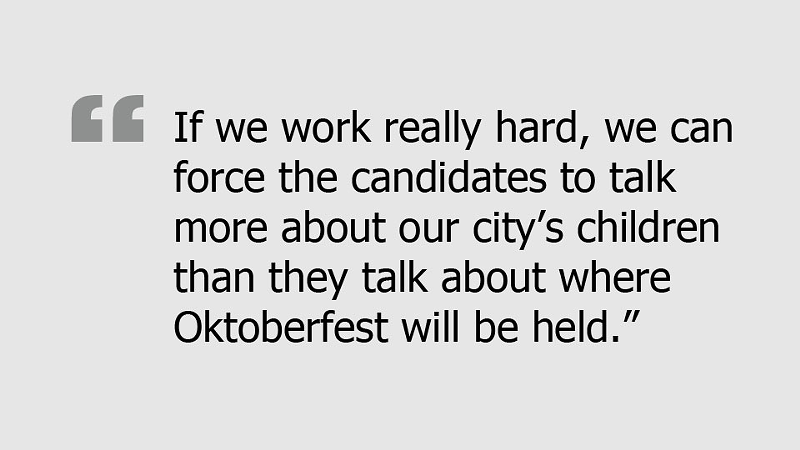EDITOR’S NOTE: CityBeat has invited three local activists to write monthly columns on pressing issues facing Cincinnati. Mike Moroski is the executive director of UpSpring, a nonprofit working to keep children experiencing homelessness connected to their education. His column will appear in CityBeat the first week of each month.
Of all the serious issues facing our city, one very literally hits vulnerable Cincinnatians where they live.
Cincinnati has a deplorable lack of affordable housing for low-income citizens, and kids whose parents cannot afford a home experience homelessness. There are too many kids experiencing homelessness in our region — 7,000, all told. It’s not just a local problem, of course. Today, the average age of a person experiencing homelessness in the United States is 9 years old.
Does this make you upset? Good. It should.
Affordable housing is defined as housing for which folks pay 30 percent of their income. Without it, kids whose parents can’t afford traditional housing have nowhere to go, or they find themselves in a perpetual state of transience. Typically, they end up on a friend or relative’s couch. But they also end up sleeping in tents in Mount Airy Forest, or at one of the few family shelters we have in town.
For context of our sickening lack of affordable housing in Cincinnati: Plan Cincinnati, a “road map” of sorts for the city, calls for 1,300 units of affordable housing to be present in downtown’s Central Business District alone. After the Anna Louise Inn (affordable housing for women) was forced to move to Mount Auburn, the number of affordable units in the neighborhood is more like 30 or 40, not 1,300.
That is pretty pathetic.
And that’s only one neighborhood.
Historically what happens is that affordable housing units tend to get concentrated in one area — presently, on the West Side. This causes folks to get upset because this concentration lowers their property value.
While the idealistic activist in me says, “Get over it; we need more housing,” the realist in me says, “I get it — why do we have to stick all the poor folks in one place until someone with means wants to live in that place and then move them again?” For an example of this, look to any historically poor neighborhood in which wealthier people decide they want to live.
It is the age-old affordable housing shell game.
These children who need affordable housing are real people — and so are their families. They deserve dignity. They do not deserve to be moved around every time someone with money wants to live in their neighborhood or redevelop their home into a hotel.
Our affordable housing structure is flawed.
Our model for redevelopment is flawed.
And our local politicians do not seem to be willing to do anything significant on the matter.
One City Council member, Vice Mayor David Mann, has talked about Cincinnati’s affordable housing problems seriously since 2013.
Mann has tried — and succeeded — to craft agreements and legislation to address the problem.
In 2014, an affordable housing ordinance Mann authored was included in a preferred developer agreement (PDA) between the city and 3CDC. This PDA states, in effect, that 3CDC gets the first shot at investigating and determining the feasibility of the redevelopment of properties owned by the city. Thanks to Mann, 3CDC must also include affordable units in its development plans.
Now, the onus is on all of us. If we demand that 3CDC and the elected officials who hold the purse strings ask developers to include affordable housing in new builds, they will.
Recently, Mayor John Cranley added money to the city’s budget for affordable housing. This is awesome. When he was on City Council, I got upset with Cranley for supporting the Housing Impaction Ordinance in 2003, which made it impossible for public funds to be used on new low-income housing in Over-the-Rhine.
The ordinance killed a great affordable housing project on Vine Street led by Over-the-Rhine Community Housing (OTRCH).
Why? Because OTRCH could not get the funds it needed to complete the project because its plan was to build low-income housing.
Ironically, many of those who now benefit from the redevelopment of Over-the-Rhine are the same ones who dislike Mayor Cranley, forgetting that this 2003 ordinance paved the way for new market-rate development by limiting subsidized housing in the neighborhood. It’s all connected, folks; just look backward for context.
Either way, Cranley’s addition of dollars to the budget should be lauded. But we need more. Not money, mind you — policy.
When I ran for City Council in 2013, I proposed anti-displacement ordinances as a good place to start protecting our affordable housing. We could also ask council to enact inclusionary zoning laws or introduce more shared equity models (go to cornerstone-equity.org for an example of this).
Those running for office will talk about what we talk about. Maybe, just maybe, if we work really hard, we can force the candidates to talk more about our city’s children than they talk about where Oktoberfest will be held.
Quality affordable housing has a direct positive impact on children living in poverty, and until we accept the fact that Cincinnati does not prioritize affordable housing, we will continue to be burdened by the second-highest childhood poverty rate in the country.
We know that when children are transient they cannot learn well. We know that when there is a lack of stability in kids’ lives that doing homework can be difficult. Conversely, we also know that a stable nighttime living situation can do wonders for a child’s academic success. We cannot talk about how we want to help all the poor kids in Cincinnati and not talk about our pathetic lack of affordable housing.
If we want results, we have to hold the right people accountable. Let’s look at City Hall and ask them what kinds of legislation they want to pass. Let’s ask them why we do not follow the advice of Plan Cincinnati. Let’s ask them to enact smart legislation.
We have some good people down at 801 Plum St. — and some good ones running next year, too — who are talking about real things. Let’s help them by being engaged.
They have a job to do, sure, but we also have a job to do as the electorate. We live in a representative democracy, which means we have an obligation to participate. Our job is to stay active. In a year when national politics has become a certifiable side show, let’s look closer to home and make some change.
In addition to leading Upspring, MIKE MOROSKI is also a trustee on the Southwestern Ohio Workforce Investment Board (Youth Employment Subcommittee), a member of Cincinnati’s Human Services Advisory Committee (Homelessness Prevention Subcommittee) and a member of Mayor John Cranley’s Hand Up Steering Committee. Additionally, Moroski serves as a trustee on the board of Invest in Neighborhoods and is currently the vice president of the Sedamsville Community Development Corporation. He is also an executive committee member of the Hamilton County Democratic Party. Moroski’s self-described passion is fighting poverty and injustice — namely, the systems that keep people poor and society unjust. His columns will appear in CityBeat the first week of each month. Contact Mike: [email protected].






